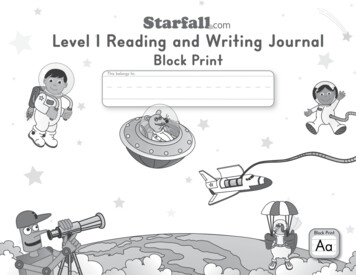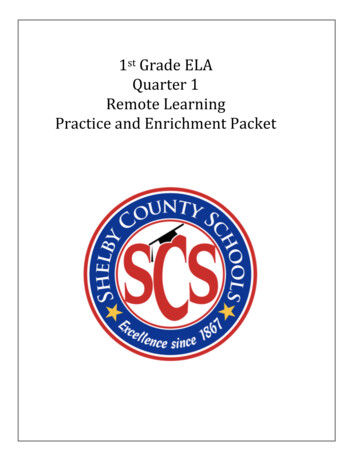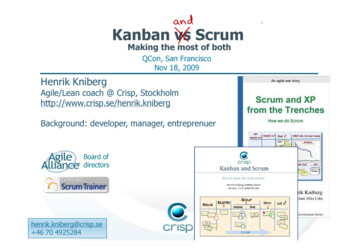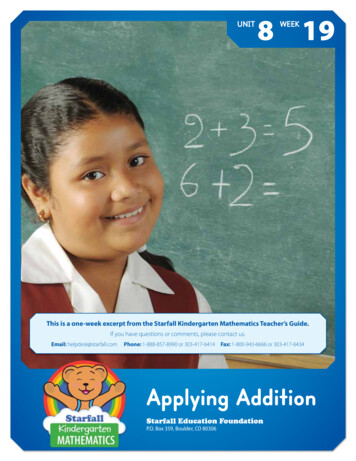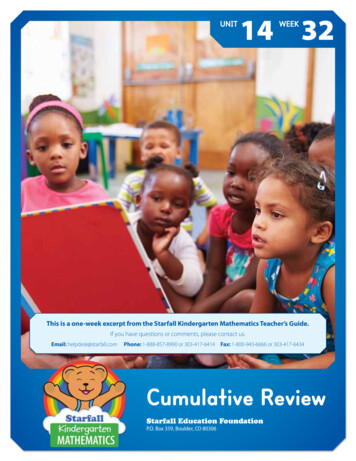
Transcription
UNIT14 32WEEKThis is a one-week excerpt from the Starfall Kindergarten Mathematics Teacher’s Guide.If you have questions or comments, please contact us.Email: helpdesk@starfall.comPhone: 1-888-857-8990 or 303-417-6414 Fax: 1-800-943-6666 or 303-417-6434Cumulative ReviewStarfall Education FoundationP.O. Box 359, Boulder, CO 80306
Starfall Education Foundation P.O. Box 359, Boulder, CO 80306 U.S.A.Email: helpdesk@starfall.comPhone: 1-888-857-8990 or 303-417-6414Fax: 1-800-943-6666 or 303-417-6434Copyright 2016 by Starfall Education and its licensors. All rights reserved. Starfall is a registered trademark in the US, the European Union, and various other countries. UNIT 14
UNIT14 32WEEKYear ReviewWeek 32Summary & Preparation . . . . . . . . . . . . . . . . . . . . . . . . . . . . . . . . 616Composing and Decomposing Numbers 6-10 . . . . . . . . . . . . . . 620Addition Game Day . . . . . . . . . . . . . . . . . . . . . . . . . . . . . . . . . . . . 622Subtraction Ball Toss . . . . . . . . . . . . . . . . . . . . . . . . . . . . . . . . . . . 623What’s the Operation. . . . . . . . . . . . . . . . . . . . . . . . . . . . . . . . . . . 624Learning Centers . . . . . . . . . . . . . . . . . . . . . . . . . . . . . . . . . . . . . . 626UNIT 14
UNIT 14WEEK32Week 32 SummaryThis week, the children will review how many more or less it takes to reach a specificnumber, composing and decomposing numbers 6-10, plus and minus signs, numberrepresentations, and estimation. The children will also: play “What’s the Operation?” solve addition and subtraction problems review shapes (“Shape Game”) play “Concentration” with Representation CardsPreparationDAY 1In today’s Magic Math Moment the children will play “I Spy” with “Backpack Bear’s MathDictionary” (See Backpack Bear’s Math Big Book, pages 47-56).Label eight individual sheets of construction paper with one number each from 7 to 10 atthe top. You will need two of each number.DAY 2Prepare two sets of index cards with one of the following numbers on each card: 1, 10, 20,50, 100, and 1000. (Two cards labeled “1,” two cards labeled “10,” etc.)DAY 3For today’s lesson you will need a large ball and a basket or box in which to placeSubtraction Equation Cards.DAY 4For today’s Magic Math Moment the children will need their math mats and their mathbags that contain bags of coins. You will also need a bag of coins for demonstrationpurposes.Have 2 index cards for each child for today’s math lesson.616 UNIT 14
UNIT 14DAY 5WEEK 32Activity Center 1 — Navigate classroom computers to Starfall.com.Activity Center 2 — The children will need dominoes and 1 or 2 “Parking Lot”game boards.Activity Center 3 — The children will need 1 or 2 “Shape Town” game boards,1 or 2 sets of Shape Cards, and a playing piece for each child in the group.Activity Center 4 — The children will need a “Number Grid: Count to 50”game board, dominoes, and a playing piece for each child in the group.Activity Center 5 — The children will need a pocket chart and RepresentationCards 1-10, (Number Cards 1-10, Domino Cards 1-10, Dice Cards 1-10, andTen-frame Cards 1-10).Note: If there are enough children in Activity Center 5 for two groups toplay simultaneously, they will need two sets of the Number, Domino, Dice,and Ten-frame Cards.UNIT 14 617
UNIT 14WEEK32Daily RoutinesDAY 1DAY 2 Calendar Place Value Weather Hundreds Chart Number Line“Our Math Dictionary”Estimate with Backpack BearComposing and DecomposingNumbers 6-10Addition Game DayMagic MathMomentMath ConceptsGroups share equationsFormative /SummativeAssessmentMath Melodies CD, Track 23Workbooks& Media618 UNIT 14Solve addition equations
UNIT 14WEEK 32DAY 3DAY 4 Calendar Place Value Weather Hundreds ChartDAY 5 Number LineLearning CentersPosition WordsCreate patterns using coinsStarfall.com (Any activity)1Where Oh Where is Backpack Bear?Solve subtraction equationsReview and make plus andminus signs“Parking Lot”2“Shape Town”3“Count to 50 Number GridGame”4“Number Concentration”5Play “What’s the Operation?”Determine the appropriateoperation to use to solve storyproblemsWrite and solve equations forstory problems (Workbookpage)Math Melodies CD, Track 29Workbook page 45UNIT 14 619
WEEK 32DAY1GeometryA.1 - Describe objectsusing shapes andrelative positions.Operations &Algebraic ThinkingA.3 - Decomposenumbers less than 11.MagicMath MomentMaterials“Our Math Dictionary”Say: This week we will review some of the math ideaswe learned this year. To review means we learned italready, and now we will talk about it again to seehow well we remember. Let’s start with a song! Ifyou remember this song, stand and join in. Play MathMelodies CD Track 23, “Ten Bears in the Bed.”F Backpack Bear’sMath Big Book,pages 47 and 48F Math MelodiesCD, Track 23Say: This year we learned about using a dictionary. Who can tell us whata dictionary is? (Volunteers respond.) Right, a dictionary is a place we canlook to help us understand, read, and write words.Indicate Backpack Bear’s Math Big Book, page 47.Continue: Since this is a special math dictionary all of the words in it aremath words. Backpack Bear would like us to play “I Spy” with some of thewords in this dictionary.Turn to page 46. Say: Look at the words that begin with Aa. I spy the word“above.” Raise your hand if you can come to the front and point to theword above. A volunteer does this. The volunteer indicates the word aboveand explains how he or she knows it is the correct word.Say: I spy (a B word). The first volunteer chooses the next volunteer, and thegame continues.Note: To make the game more interesting, skip around in the dictionary.MaterialsComposing and DecomposingNumbers 6-10F Prepared paper labeledwith numbers 7-10F Pencils1 Composing and Decomposing 6Gather the children in front of the classroom whiteboard. Say: Today let’s write allof the different equations we can for numbers. We’ll try one together.Write the number 6 on the board. Ask: What’s an equation that equals 6?You or a volunteer write the equation on the board. Volunteers continue namingequations that equal 6 and listing them on the board.Note: If the children are not able to think of several equations for a number,Backpack Bear may suggest one, such as 7-1 6. Encourage the children to createboth addition and subtraction equations.620 UNIT 14
U2 Composing and Decomposing 7-10WD14 321Divide the class into groups of 3 and distribute a sheet of paper with the number 7,8, 9, or 10 on it to each group. The children in each group work together to createas many equations as possible to equal that number. Assign one child in eachgroup to write the equations on the paper.Note: More than one group may have the same number depending on thesize of your class.Formative AssessmentRecord ResultsRecord the equations on the whiteboard as each group shares its results. The classconfirms whether or not the equations equal the target number.UNIT 14 621
WEEK 32DAY2EstimationE.1 - Understand themeaning of estimation.Operations &Algebraic ThinkingMagicMath MomentEstimationSay: Today let’s do some estimation with BackpackBear! Who can choose a number between 4 and 40?A volunteer does this.MaterialsF Estimate withBackpack BearTurn to the corresponding page in Estimate withBackpack Bear and lead the children to complete theestimation activity. A different volunteer chooses anumber and the children complete the estimationactivity on that page. Continue as time allows.A.2 - Solve word problemswith addition andsubtraction within 10.MaterialsAddition Game DayF Prepared Point Value Cards (2 sets)F Addition Equation CardsDivide the class into two teams and write Team 1 andTeam 2 on the whiteboard.Say: Today we will work in teams. Each team will have a set of point cardswith different numbers on them.Distribute a set of point cards face down to each team.Continue: The teams will take turns. I will show you an equation card.The first person on the team will give the answer. If the answer is correct,he or she will reveal an index card that tells how many points the teamreceives. You might receive 1 point or you could receive 1,000 points! If youranswer is not correct, you may ask other children on your team for help.I’ll be the scorekeeper. Ready?Continue play as time allows.622 UNIT 14
MagicMath MomentMaterialsPosition WordsSay: Today we will review our book about positions.First, let’s sing “This Old Man.” As we sing, let’s createactions to go with the song. Be sure to point towhere the old man played knick-knack each time!Ready? Let’s stand.F Where Oh Where IsBackpack Bear?F Math MelodiesCD, Track 29WEEK 32DAY3GeometryA.1 - Describe objectsusing shapes and relativepositions.Play Math Melodies CD Track 29, “This Old Man.” Encouragethe children to sing along.Operations &Algebraic ThinkingRead Where Oh Where Is Backpack Bear? Pause to discussillustrations and review position words as you read.A.2 - Solve word problemswith addition andsubtraction within 10.MaterialsSubtraction Ball TossF BallF Subtraction Equation Cardsin a basket or boxGather the children in a circle. Say: Today we will playa subtraction game with a ball and the SubtractionEquation Cards. The game is called “Ball Toss.”Choose a “helper” to stand next to you with the basket (or box) of equation cards.Continue: I will toss the ball to one of you. (Helper’s name) will remove anequation card from the basket and show it to you. If you caught the ball,you will tell us the answer. If the answer is correct you will toss the ball toanother child and he or she will answer another equation. If the answer iswrong, you will toss the ball back to me and I will toss it to another child.Ready?If necessary, remind the children that only the child who caught the ball shouldanswer.Note: You may alternate helpers to give several children a turn.UNIT 14 623
WEEK 32DAY4Measurement & DataB.3 - Classify, count, andsort objects.Operations &Algebraic ThinkingA.2 - Solve word problemswith addition andsubtraction within 10.MagicMath MomentMaterialsPatterns Using CoinsF Math bags withbags of coinsGather the children in a semicircle on a rug or the floor.Say: Today we will use your math mats and the coinsin your math bags to create different patterns. Let’stry one together.F Math matsF Teacher bag of coinsSpread the coins from you bag onto the floor. Continue: Who can createa pattern using my bag of coins? A volunteer does this. The childrendetermine the pattern.Distribute the math mats and math bags.Say: Now you will use your own coins to create patterns. Remove allof the coins from your math bag and place them on your math mat.The children do this.Say: Raise your hand if you can tell me which coins you have. (Volunteersrespond.) Right, you have pennies, nickels, and dimes. Think of a patternyou could create with them.The children create patterns and share them with the class.MaterialsWhat’s the Operation1 Review Plus and Minus SignsF Backpack Bear’s Math BigBook, pages 43 and 45F Backpack Bear’s MathWorkbook #2, page 45F Two index cards per childSay: This year we have learned about theF Pencils, crayonsoperations of addition and subtraction. Whoremembers the difference? (Volunteers respond.)Right, when we add we put numbers together and then we have more.When we subtract we take numbers away and then we have less.Indicate Backpack Bear’s Math Big Book. Review the plus sign on page 43 and theminus sign on page 45. Say: When we add or subtract we call these operations.The plus and minus signs are very important because they tell us whichoperation we should do.2 Make Plus and Minus SignsDistribute two index cards to each child. Say: Use your crayon to make a plussign on one index card and a minus sign on the other. (The children do this.)You will use these signs today to play a game called “What’s the Operation?”624 UNIT 14
U3 Play “What’s the Operation?”WD14 324Say: Listen closely to this number story and decide which operation, additionor subtraction, we should use to solve the problem. Ready? Story #1—One flower has 5 petals. Another flower has only 4 petals. Howmany petals do the flowers have altogether? What’s the Operation?The children hold up their plus or minus signs to indicate the correct operation tosolve the problem.Repeat the story problem. A volunteer solves it and explains how he or she knewwhich operation to use.Continue the above procedure for the following story problems. Emphasize keyterms (altogether, how many are left, etc.) as you read the problems, and remind thechildren to use these clues to help them make their choices. Story #2—One tree has 3 apples. Another tree has 4 apples. If Tommypicks all the apples from both trees how many apples will he have?What’s the Operation? Story #3—Eight children were riding bikes. Two of the childrenneeded to go home. How many children were still riding their bikes?What’s the Operation? Story #4—Susi and John each have two balloons. How many balloonsdo they have altogether? What’s the Operation?Formative AssessmentWhat’s the Operation?Distribute Backpack Bear’s Math Workbook #2. Instruct the children to turn topage 45. If you have projection capabilities, project this page for demonstrationpurposes.Say: We will work the first problem together as an example. Who canread the first problem? A volunteer does this, with your assistance if necessary.The children draw pictures to represent the story. They color the box that shows thecorrect operation to use to solve the problem. Then they write the correspondingequation and solve the problem.UNIT 14 625
WEEK 32DAY5Operations &Algebraic ThinkingA.1 - Representaddition andsubtraction ina variety of ways.A.3 - Decomposenumbers less than 11.GeometryA.2 - Correctlyname shapes.Learning Centers1ComputerThe children explore their favorite Starfall.commath activities.MaterialsF Classroom computernavigated toStarfall.comNote: The children may enjoy being allowed to explore the first grade mathonline activities in addition to the kindergarten activities they have exploredthis year.2“Parking Lot”The first child selects a domino, adds the dots on thedomino, then “parks” the domino in the appropriateparking space.MaterialsF 1 or 2 “Parking Lot”game boardsF Dominoes placedface downIf the child chooses a domino that equals the samevalue as one already on his or her board, he or shestacks it on top.The children take turns. The first child to fill all of hisor her parking spaces wins, or the game continuesuntil both children fill their spaces.3“Shape Town”The children take turns drawing from a stack ofShape Cards. They move to the next correspondingshape on the game board. Play may end when a playerreaches the star, or play may continue until both playersreach the star.626 UNIT 14MaterialsF 1 or 2 twodimensional “ShapeTown” game boardsF Shape Cards (1or 2 sets)F One playingpiece per child
U4“Count to 50 Number Grid Game”The children place the dominoes face down. They placetheir playing pieces at 0 on the game board.For each turn the player turns over a domino andadds together the dots on both sides then moveshis or her playing piece the corresponding numberof spaces.MaterialsWD14 325F “Count to 50”game boardF Playing piece foreach playerF DominoesPlay ends when the first player reaches 50.Note: For a more challenging game use the Countto 100 side of the game board.5“Number Concentration”MaterialsF Pocket chartNote: If two groups play simultaneously, they will needtwo sets of Number, Domino, Dice, and Ten-frame Cards.F Number Cards 1-10The children mix together the different sets of cards andarrange them face down in a pocket chart. They taketurns to reveal two of the cards.F Dice Cards 1-10F Domino Cards 1-10F Ten-frame Cards 1-10The goal is to find two cards that represent the same number. If a match is madethe child places the cards on a table or on the floor and takes another turn.If a match is not made, the child turns the cards face down and play continueswith the next player. You may vary the game by forming two groups.UNIT 14 627
In today's Magic Math Moment the children will play "I Spy" with "Backpack Bear's Math Dictionary" (See Backpack Bear's Math Big Book, pages 47-56). Label eight individual sheets of construction paper with one number each from 7 to 10 at . Algebraic Thinking A.3 - Decompose numbers less than 11. Materials F Backpack Bear's .


